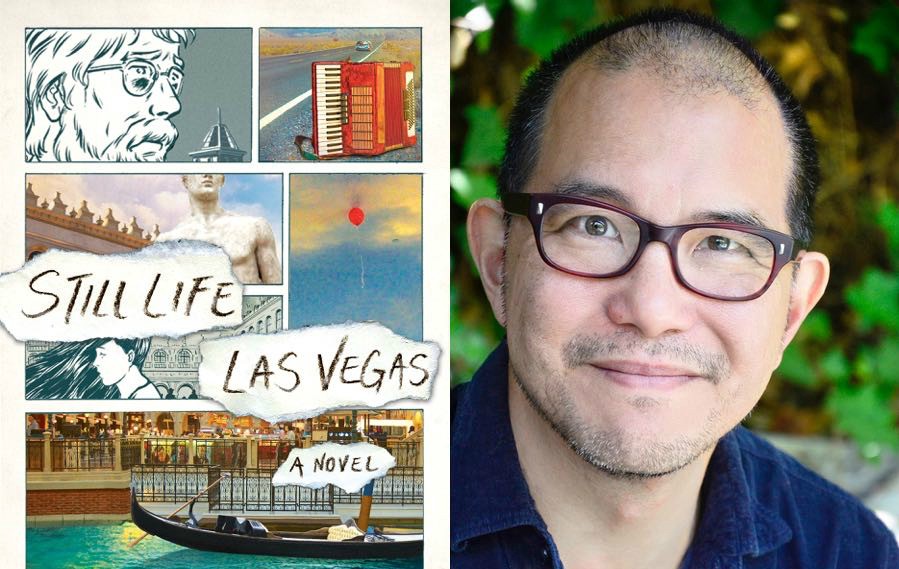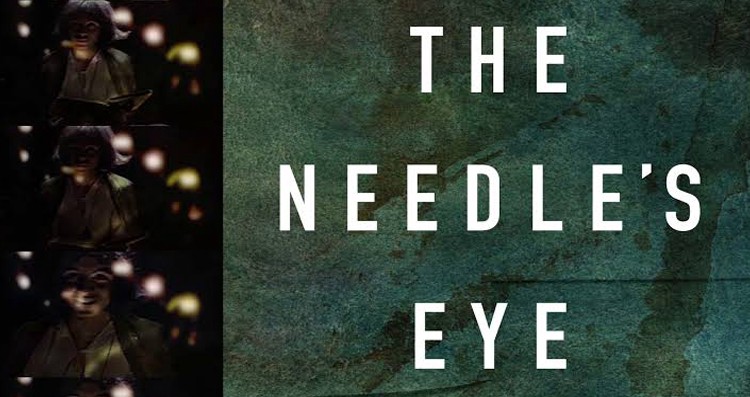interviews
The Magic Behind The Artifice: An Interview With James Sie, Author Of Still Life Las Vegas

James Sie is a busy man. When he’s not writing, he’s acting and voicing characters in several popular cartoons and video games. His debut novel, Still Life Las Vegas (St. Martin’s Press, 2015), is a love letter to the mythical city in the desert. Sie’s work is interspersed with striking illustrations by Sungyoon Choi. In Still Life, Walter, 17, searches for the mother who abandoned him. Las Vegas provides a theatrical backdrop; Walter’s discoveries lead him to acceptance of himself, but also of the stories that his father told him so that they might survive. Details of deep human connection set this coming-of-age novel apart from others like it; Sie’s wit and wordplay also make it a treat for the ear.
I connected with James Sie recently over email to talk visions of Liberace, Lucy Liu’s accordion, and the mythical inspiration for his Las Vegas opus.
Heather Scott Partington: In Still Life Las Vegas, you write about tragedy without the story becoming tragic. How did the idea for this story come to you? Did you start with the accident that becomes a touchstone, or did you conceive of the novel some other way?
James Sie: First off, I’m glad you didn’t think it was tragic! Reading over it now, I do see that many dark circumstances befall my characters, but I honestly never thought of it a dark piece. It’s just kind of the way I see life.
Running, Vegas, accordion. It all unspooled from there.
I remember conceiving of the story through action: a woman, running away. Why was she running away? I had no idea. Then, I visited Las Vegas for the first time and thought that it would be a most interesting place to be running to. Then, I found out Lucy Liu played the accordion as a child, and the image of a little Chinese girl with a red accordion made things very interesting to me. Running, Vegas, accordion. It all unspooled from there.
HSP: This is a novel that blends many things: pop culture, art, mythology, and the relationship of fathers with their sons. Was there something from your own life as a parent or as a son that you felt it was important to include in Owen and Walter’s relationship?
JS: It’s funny — my father is almost the exact opposite of the father in the novel. My dad is sharp, decisive and almost maniacally positive, while Owen is fuzzy, plagued with self-doubt and mostly prone. So I didn’t look to him for example! I do think that when I began the book, I was a new father myself, and the instinct to protect your child at all costs, and the cost of not protecting your child, was always in the forefront of my mind. I have to say, I probably relate a little more to Emily as a parent than Owen — I am the one with the lists, the endless lists.
HSP: Liberace is also important to the story. I love that you included such an icon of Vegas opulence and, in a way, Vegas history. Talk to me about how that (and Emily’s vision of him) came to you.
JS: Liberace’s huge in my book! My first draft was actually titled “Liberace Under Venetian Skies.” I’ve made him the deity of Las Vegas, representing all the promise, and artifice, that Vegas has to offer. When I first visited the Liberace Museum (sadly, now defunct) I was struck by how emblematic a presence he was, back in his prime. He wasn’t the mincing punchline that many people think of today, but a much warmer presence. To Emily, he embodied both the hope of the past and a way out in the future. Because he was so much larger than life, it was easy for him to become the magical totem of the book.
HSP: Through Owen you are able to include a lot of Greek mythology. This gives some nice weight to the struggles of Walter to understand both himself and his place in his family. How does this connect to his understanding of his family’s mythology?
Because all family history is about storytelling.
JS: In a way, Still Life Las Vegas is all about family myths, our own origin stories, the stories that explain how we got to where we are. Because all family history is about storytelling. One of the big joys of writing the book was doing all the research into Greek mythology — not only the classic myths, like Orestes and Odysseus and Orpheus (I seemed to have covered all the mythological O’s!), but those from the more ancient, arcane religions in Greece. I loved layering these myths with family stories and even invented mythology to create a prism through which these characters view their past. Facts are their own kind of myths. And in order for Walter to break free from the past, he has to come to terms with that.
HSP: Still Life is filled with striking graphic art. Did you have a concept of how you wanted these pages before you found Sungyoon Choi, or was the artwork a collaboration that happened after she joined you to work on the novel?
JS: I had a clear idea of how I wanted the pages to look — the number of panels, where the captions would go, what the central images were — during my first drafts. I had pretty detailed scripts for those sections. But I realized early on that in order for me to sell this somewhat unique hybrid of prose/graphic novel, I had to have some finished samples to submit. I just happened to read a great graphic memoir called American Widow by Alissa Torres, and I was struck by the illustrations. On a whim, I emailed the illustrator, Sungyoon Choi, to see if she would be interested in working with me on the novel, and enclosed fifty pages. To my utter shock, she said yes. Sungyoon stuck with me for the years it took to find an agent, illustrating two complete graphic novel sections on spec. I might still be waiting around for an agent without those sections. And of course she instantly made my ideas better and more beautiful. It was a wonderful collaboration.
HSP: Vegas provides a rich backdrop and the opportunity to describe a cadre of colorful tourists and employees. Who was your favorite? What made it into the book that might surprise readers?
JS: Well, of course, I have to say that my personal favorite characters among the denizens of my Las Vegas is the brother/sister team of Greek living statue performers, Chrystostom and Acacia. The idea is that they are so exquisitely trained, they can change positions without anyone ever seeing them move; I’ve had fantasies about being able to do this. To have such control over your body… She is a diva and immensely fun to write for, and he is the beautiful, sexy avatar of every unrequited crush I’ve ever had.
I think the most surprising characters for the readers would be Little Bang and Big Bang, the flamboyant vandals of the Liberace Museum. They come out of nowhere, like they’ve stepped out of an Elmore Leonard heist, just as things are at their darkest, and take the book in a whole new direction.
HSP: Vegas is a place that’s false, but in a theatrical way — like what the tourists see is a staged environment created to keep them happy and not let them think too much about the real world. How did this factor into your story? Did it give you any particular opportunities or challenges?
Las Vegas is the ultimate city of reinvention. It creates its own myths fresh, daily.
JS: Las Vegas is the ultimate city of reinvention. It creates its own myths fresh, daily. When I visit Las Vegas, I am struck but how it appropriates every important cultural icon in the world for merciless exploitation — and yet, those icons still retain a bit of their potency. To be aware of the artifice and still find the true magic behind it, that’s the Las Vegas I wanted my characters to discover.
At the same time, I liked the opportunity to display what life is like beyond the Strip, where the only neon you see is in the distance: “Lady Luck turning it’s back to us.” That tension between the shiny, aspirational city we usually think of, and the grime of day-to-day behind it all was a great thing to play with.
HSP: I always like to ask this — a lot of people ask writers about their writing process, but I’m interested in your reading process, too. What did you read that influenced (or inspired) Still Life? What are you reading now?
JS: Like two sets of grandparents, my book found its roots in two genres. On the graphic novel side, I am beholden to Neil Gaiman, whose Sandman series serves up modern mythology of dizzying invention and soul-satisfying complexity (his examples of graphic novel scripts also helped me format a template for my own communication with the artist); and Alison Bechdel, who, in her memoir Fun Home, showed me just how emotionally complex and resonant a comic can be. On the prose side, John Irving’s The World According to Garp, a touchstone book for me, contains all the emotional darkness and wonder I strive for (plus amazing storytelling); and Margaret Atwood (Cat’s Eye, The Handmaid’s Tale) always dazzles in her writing — so poetic but so visceral at the same time; never an extraneous word.
What am I reading now? I’m a third of the way through The Paper Man by Gallagher Lawson — a strange, wonderful story about a man who is made of paper living in a fictitious quasi-European town where mermaid corpses are found on the streets and women smell of mushroom broth. It’s right up my alley. And I’ve just finished the graphic book called Here by Richard McGuire. It’s almost wordless, and it focuses your attention on one corner of a room from the beginning of time to the future — simultaneously. It’s pretty amazing.
HSP: What’s next for James Sie?
JS: I’m still doing a bit of touring for the book, and then I’m reworking an adaptation I did of A Wrinkle in Time for a production at Lifeline Theatre in 2016. After that, I hope to be settling down with a pack of Los Angeles coyotes and awaiting inspiration.









